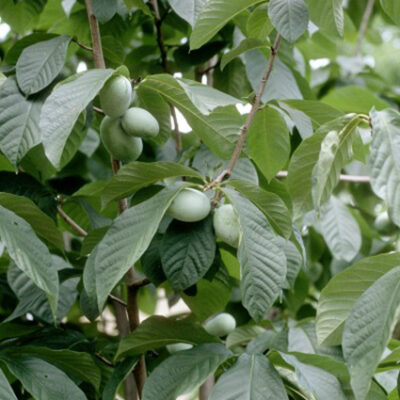Garden Plant: Paw Paw
Product Description: Paw Paw

Native Tropical Paw Paw Tree
- Edible, Custardy Tropical Fruit
- Spring and Fall Color
- Disease Resistance
- Hardy and Cold Tolerant
- Long History
A favorite of George Washington and Thomas Jefferson, the Paw Paw (Asimina triloba) is an incredible native fruit that brings the taste of the tropics home. Have you ever heard of it?
This special tree grows the largest native fruit in the United States. Related to a tropical type of fruit called a Cherimoya in the family Annonaceae, this tree doesn’t grow in the tropics. It grows in the Southeast and Midwest of the United States as an understory tree in the woods. Native Americans, the Founding Fathers, and settlers throughout Appalachia and the Southeast alike appreciated this tree.
But today? The largest edible fruit native to North America is not often found in grocery stores. Why? They are delicious and have a long history of use.
Well, they ripen best while hanging on the tree. They don’t transport long distances well.
However, the Paw Paw fruit is really starting to pick up in popularity. This is a perfect locally sourced, seasonal food source for farmer’s markets. As you know, gardeners and food-lovers across the country are “hungry” for new experiences.
Microbreweries across the country have started to use the tropical fruits in seasonal beer recipes. And with the growing interest in Homesteading, the word is out about the Paw Paw.
For the best supply, we recommend that you grow your own trees to produce fruit. You’ll love using this exotic, fruit-bearing native tree in your landscape.
Dark purple flowers open and bloom early in spring. Each bloom is a delightful, 1-inch bell-shaped flower. The flower buds are also quite charming. You’ll definitely notice them, as they appear before the long leaves appear.
Large, deeply textured leaves really add to the tropical look, and they’ll turn a brilliant yellow in fall. These are deciduous trees, so they’ll drop their leaves for winter. Because each leaf is so large, it’s an easy task to clean up.
Now for the best part. The most popular feature of these fruit trees is the large, tropical fruits that are produced in the fall.
Order yours today, we have a hard time keeping them in stock!
How to Use Paw Paw Fruit
You’ll adore the short, stubby-banana shape and creamy consistency of the ripe, custard-like ripe fruits. It’s about the size of a large potato.
The unique taste must be tried to be truly appreciated. People describe it as a banana flavor with papaya, mango, melon, vanilla or even pineapple accents. Incredible!
Inside, it’s a creamy yellow and has a soft texture like ice cream. You’ll need to be ready to prep them once they are ripe.
You’ll want to save some to eat fresh. Nicknamed “poor man’s bananas”, you can use them as a replacement for bananas in your cooking. They make wonderful quick breads and preserves. You can freeze the pulp as frozen puree.
Homebrewers, try using the Paw Paws as a bright fruity base for a light Belgian-style ale. Or go old school and ferment them into homemade brandy or wine. Just right for what “ails ya. “
These superfruits are chock full of nutrients, including antioxidants, Vitamin C and B6, magnesium, potassium, phosphorus, iron and folate.
How to Use Paw Paw in the Landscape
This is a unique tree that is sure to turn heads if planted near your street or by the front entrance of your home. It’s a mid-sized tree that brings a lush look.
Plant at least 3 together in a grove for the best cross pollination in an edible garden. Plant 4 feet apart.
Or, as an ornamental, consider using the Paw Paw as a fabulous specimen tree. The large leaves give it a dramatic, coarse texture. It’s fun to play off that by contrasting it with fine-textured plants like Ornamental Grasses, Azaleas or smaller flowering shrubs around it.
If you want to encourage butterflies, You’ll like hearing that these leaves are used by Zebra Swallowtail butterfly caterpillars as a food source.
Pro Plant Tips for Care
Planting a Paw Paw is a great way to bring a bit of tropical allure to your yard without concerns about harsh weather. The Paw Paw can tolerate cold temperatures, even as low as -25 Fahrenheit.
Paw Paws are an understory plant and will work well as a naturalized tree at the edge of a forest setting in moist soil. They really like a lot of organic matter in their soil.
In hot, dry climates, site them so they’ll receive morning sun and afternoon shade. Mulch them heavily with a thick 4-6 inch deep layer to 2 feet outside the canopy to keep their roots cool.
If you see these in stock on our site, place your order today. They sell very quickly.


